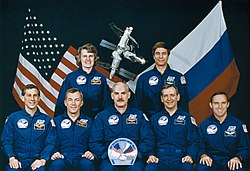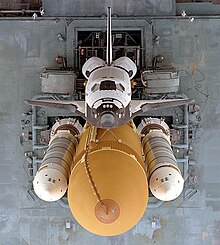STS-79
| Mission emblem | |||
|---|---|---|---|

|
|||
| Mission dates | |||
| Mission: | STS-79 | ||
| COSPAR-ID : | 1996-057A | ||
| Crew: | 6th | ||
| Begin: | September 16, 1996, 08:54:49 UTC | ||
| Starting place: | Kennedy Space Center , LC-39A | ||
| Space station: | Me | ||
| Coupling: | September 19, 1996, 03:13:18 UTC | ||
| Decoupling: | September 24, 1996, 01:31:34 UTC | ||
| Duration on me: | 4d 22h 18m 16s | ||
| Landing: | September 26, 1996, 12:13:13 UTC | ||
| Landing place: | Kennedy Space Center, Lane 15 | ||
| Flight duration: | 10d 3h 18m 24s | ||
| Earth orbits: | 160 | ||
| Rotation time : | 92.1 min | ||
| Apogee : | 385 km | ||
| Perigee : | 375 km | ||
| Covered track: | 6.3 million km | ||
| Team photo | |||
 v. l. No. back: Shannon Lucid, John Blaha front: Jay Apt, Terrence Wilcutt, William Readdy, Thomas Akers, Carl Walz |
|||
| ◄ Before / After ► | |||
|
|||
STS-79 ( English S pace T ransportation S ystem) is a mission name for the US space shuttle Atlantis ( OV -104) of NASA . The launch took place on September 16, 1996. It was the 79th space shuttle mission and the 17th flight of the space shuttle Atlantis, the sixth flight as part of the Shuttle Mir program and the fourth coupling of the shuttle to the Mir space station .
team
Shuttle crew
- William Readdy (3rd space flight), commander
- Terrence Wilcutt (2nd space flight), pilot
- Thomas Akers (4th space flight), mission specialist
- Jerome Apt (4th space flight), mission specialist
- Carl Walz (3rd space flight), mission specialist
Me crew outbound
- John Blaha (5th space flight)
replacement
- Jerry Linenger for Blaha
Me crew return flight
- Shannon Lucid (5th space flight)
(Returned to Earth after a flight time of 188 days, 4 hours and 0 minutes; one-way flight on STS-76 )
Mission description
The fourth flight of a space shuttle to the Mir space station was primarily used to transport 2.3 tons of material to the station. In addition, Shannon Lucid was replaced by her colleague John Blaha after half a year in space. Some experiments in Spacehab completed the crew's work program.
On the third day of flight, the Atlantis docked with the coupling module of the Russian space station. Then water cans, food, clothing, equipment and American experiments were brought into the station. Above all, samples from various experiments and disused devices were brought back to earth. For the first time, all objects to be transported were provided with a barcode. This made it possible to record exactly which materials had already been brought into the space station (inventory management system). This also included the BioTechnology System experiments to investigate the growth of cartilage cells, Commercial Generic Bioprocessing Apparatus to observe growth processes in plants, and Materials in Devices as Superconductors to investigate high-temperature superconductors. All systems were accommodated in the new Priroda station module. During the joint flight, several engine ignitions were carried out in order to test a system with which sensitive experiments are to be protected from external forces ( Active Rack Isolation System ARIS ). This mainly dampens vibrations with low frequencies from 0.003 to 300 Hertz. At the same time, it was recorded how the forces affect the stability of the entire Mir / Shuttle complex. In addition, a special IMAX film camera was used to take high-resolution images of the facilities at the station and the space shuttle.
Various scientific experiments were carried out on board the Atlantis. It was investigated how cracks and fissures arise in cast or sintered metals ( Extreme Temperature Translation Furnace ). In addition, protein crystals were produced which are to be used as drugs against asthmatic and allergenic diseases ( Commercial Protein Crystal Growth ). Further investigations were the mechanical strength and stiffness of granules ( Mechanics of Granular Materials ), the interference of radio transmissions by interference ( Mir Electric Field Characterization ) and the determination of radiation exposure and its effects on coliform bacteria and plasmid DNA ( Real-time Radiation Monitoring Device ).
Press conferences and contacts with radio amateurs loosened up everyday life a little. The Atlantis landed on the grounds of the Kennedy Space Center in Florida.
See also
Web links
- NASA Mission overview (English)
- Video summary with comments of the crew (English)
- NASA video of Mission (English)


